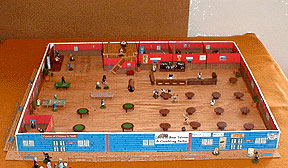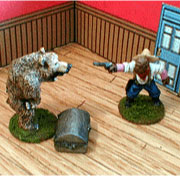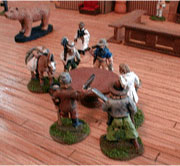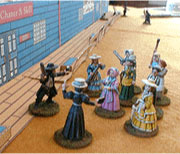
Creating Characters
Each player controls four outlaws. I like to give the players more than four to choose from so they can pick their favorites. Try to divide the figures so that each team has something in common, to make it easier to identify the factions after the fighting starts. The factions I use include: the Red Sombreros (Mexican banditos), Chinese, Hole in the Head Gang (bandanas over their faces), Dusters, Southerners, Indians, Cowboys (ten gallon hats and chaps), and the Young Guns (bowler hats). The four figures each player gets will vary in quality from a "legend" down to a "greenhorn." Each figure has four attributes: aim, melee, save, and hit points. Players roll for their hit points according to the character sheet (18 + 1-4 D6). Each figure should be given a name, and the player should make a note about its appearance so the figure can be easily picked out in a crowd.
Sheriff Bart: "Oh, baby. You are so talented. And, they are so dumb."
Weapons:
Each outlaw is armed with the weapons modeled on the figure. All weapons are assumed to be fully loaded at the start of the battle: pistols have six shots, rifles have four shots, shotguns have two shots, and bows have ten shots. Players should draw a circle in the ammo section of the character sheet for each available shot. The figures do not have the ammunition to reload their weapons, so players should keep an accurate record of how many bullets they have left.
Sheriff Bart: "Don't just stand there clasping your hands in pain... How about a round of applause for The Waco Kid?"
The Deck
Each player should prepare one card for each figure (write the figure's name on the card) and one Wild Card (write the player or faction's name on the card). It's no fun waiting for your card to come up, so separate the cards into at least three decks, keeping the cards from each faction together in the same stack. For example if you have factions A, B, C, D, E, F, and G put the cards for A - C in one stack, D - E in another, and F - G in a third stack. Shuffle them before each turn.
Turn one card over from each stack. These figures act simultaneously, but attacks always come before movement. If the card has the name of a figure, that figure gets one action. If it's a wildcard the player can choose ONE of their figures to get the action. Typically an action will be to EITHER move or attack. Turn the cards over as rapidly as possible. Keep the action lively. Sometimes, in all the excitement, a player will miss one of his cards.
Allow the player to take his action at the end of the turn. The referee should prepare three cards: Employees (for the owner, guards, bartenders, and the bear), Bystanders (for the photographer, doctor, Mongo, and other bystanders), and Law & Order (for the sheriff, his deputies, and the Christian Women's Temperance League, and the US cavalry). The referees cards should be mixed in with the players cards. It doesn't matter which stack, try to keep the number of cards in each stack about even. When one of the referee's cards some up ALL of the figures on that card get one action.
Hedley Lamarr: "Unfortunately there is one thing standing between me and that property - the rightful owners."
Shooting:
A figure may fire at any other figure it can see and that is in range (see the combat chart). Other figures do not block line of sight, but there is a chance that a stray bullet will hit someone else. The figure may not move (other than to change facing) and attack, the figure must already be in position to attack. The figure may use any available weapon that has ammunition; it does not take an action to switch weapons. To execute the attack the figure must roll less than or equal to his aim number on a D20. If the target is at long range then the figure must roll less than half of his aim number (round down).
If successful the target takes damage - look at the combat chart for the correct number of dice to roll. Each weapon may fire one bullet or arrow per action (exception: shotguns). A figure may fire two weapons if he has them. The second weapon hits only if the roll is less than or equal to half of the aim number. Some characters may have special abilities and are exceptions to this rule.
Stray Bullets:
If a figure shoots and misses the bullet or arrow may hit someone else. Trace the line of fire from the firer to the target and beyond. Any figure whose base is directly in the path of fire may be hit. Each figure in the way must pass a saving roll (less than or equal to its save number on a D20) or it takes the bullet and the damage. Start with the figure that is closest to the shooter. If that figure passes the check then the next figure must roll.
Continue until someone is hit, or all the figures in the line of fire have been tested. Too many stray bullet checks will slow down the game, so only check figures that really are in the direct line of fire.
Shotguns
Shotguns do not require a roll to hit. They will hit automatically, but the target gets a chance to save to reduce the damage. If the shot is close range then a save will result in half damage.
At long range a successful save results in no damage. The shotgun can hit more than one target. Assume the weapon effects figures in a cone about 45 degrees wide. It can hit two figures standing next to each other at close range, and up to three figures at long range. Shotguns have two barrels. The barrels may be fired one at a time, or both simultaneously.
Reloads:
If a figure has access to additional ammunition he can load up to three bullets or shells in one action.
Hedley Lamarr: "My mind is a-glow with whirling transient nodes of thought, careening through a cosmic vapor of invention."
Movement
A figure may move 6" in one action. The figure may follow any path as long as it isn't more than 6". The figure may end his movement facing any direction he wishes. If the base of the figure crosses any inanimate obstacles, such as jumping over the bar or stepping over a dead body, he must pass a saving throw (roll less than or equal to his save number) to avoid falling.
If a figure falls it is tipped over and placed on the other side of the obstacle. The figure must use its next action to get up. A figure may not pass another figure if there isn't a gap equal to the figure's base. This rule allows outlaws to block doors and trap opponents in corners. Once a figure leaves the saloon it may not return.
Taggart: "What in the wide, wide world of sports's a-goin' on here?!"
Stunts:
A player may want his outlaw to perform some kind of stunt, like jumping off the balcony onto the back of an opponent, or vaulting off a table and drop kicking the sheriff. These maneuvers should always be encouraged, they're fun. Figures attempting a stunt of some kind must pass a saving roll on a D20 or they fall.
If it seems appropriate, a figure failing the saving roll may take 1D6 damage in addition to falling. Exceptionally difficult or ridiculous stunts may require the figure to roll less than half of his save number, at the discretion of the referee. The referee should decide what effect the stunt has on any opponents. Typical benefits of a successful stunt are getting an extra 1D6 of damage, or forcing the target to pass a saving roll to avoid being knocked down.
Jumping through Windows:
Sooner or later a player will want to jump through a window. The safe way to do this is to spend one action smashing the glass. On the next action the player may exit without any difficulty, carrying their loot (provided the loot isn't a large object like a mule or a dance hall girl).
The dangerous way is to simply run up and jump through the glass like a Hollywood stuntman. This maneuver requires a successful saving roll. If the figure fails he falls down INSIDE the saloon and takes 1D6 damage. The good news is that now the window has been properly smashed, so after the figure gets up it can exit the window without another saving roll. The windows in the bedroom where the bear and strong box are located are stoutly barred; so don't even think about trying to escape that way.
Buddy Bizarre: "Not the face! Not the face! *Ooof* Thank you."
Melee:
A figure must be within arm's reach (about ½ inch) to attack another figure in melee. The figure may not move (other than to change facing) and attack, the figure must already be in position to attack. The figure may use any available weapon; it does not take an action to switch weapons.
To execute the attack the figure must roll less than or equal to its melee number on a D20. If successful the target takes damage - look at the combat chart for the correct number of dice to roll. The line in the chart for "hand weapon" includes any melee weapon more dangerous than a knife, such as a saber, tomahawk, machete, or war club. A figure may attack with two melee weapons if it has them (but not one weapon and a fist, or two fists). The second weapon hits only if the roll is less than or equal to half of the melee number. Some characters (usually Chinese) have special melee abilities and are exceptions to this rule.
The Waco Kid: "I must have killed more men than Cecil B. De Mille."
He's Dead Jim
When a figure runs out of hit points it dies. The figure should be replaced with a casualty marker. Dead bodies, and the pools of blood that accompany them, are obstacles. If a moving figure crosses a dead body it must pass a saving throw to avoid falling down.
Winning the Game
At the end of the game the player with the most victory points is the winner. There are a lot of different ways that a player can get victory points. This was done deliberately, so each person can play the kind of game they like.
Some players will blaze away at anything that moves, other players are goal oriented and will try to grab valuable items without getting mixed up in a gunfight.
IMPORTANT: make sure the players keep track of their victory points during the game.
Hedley Lamarr: "My mind is a raging torrent, flooded with rivulets of thought, cascading into a waterfall of creative alternatives."
Non-Player Characters
There are quite a few figures in the saloon that are controlled by the referee. Their stats are in the referee's character sheet. Nobody cares if they live or die, so they have just one number that they use for aim, melee, and saves. If a player is unfortunate enough to lose all of his figures early in the game the referee should allow him to control some of these non-player characters, such as the US cavalry, or the sheriff and his deputies.
The Owner: Gristly Adams was a mountain man before building the saloon. His Indian name was Sleeps With Bear, or Sleepy Bear for short (hence the name of the saloon). But don't get the wrong idea, he and the bear were just good friends, it was a Platonic relationship. One day he got lucky and found some gold in the hills. He returned to civilization and built a saloon and gambling parlor. He starts the game in his office with a loaded shotgun.
The Waco Kid: "If you shoot him, you'll just make him mad. "
 The Bear: The bear guarding the strong box is sleeping (maybe). When a figure enters the bedroom he must draw a Bear Card. The card will reveal just how deeply the bear is sleeping. Follow the directions on the card (see the Bear Cards for full details). If the bear wakes up it will attack. If the bear continues to sleep the player will have to draw another Bear Card each time he performs an action in the room.
The Bear: The bear guarding the strong box is sleeping (maybe). When a figure enters the bedroom he must draw a Bear Card. The card will reveal just how deeply the bear is sleeping. Follow the directions on the card (see the Bear Cards for full details). If the bear wakes up it will attack. If the bear continues to sleep the player will have to draw another Bear Card each time he performs an action in the room.
If the figure escapes the room without waking the bear then the bear will wake up automatically the next time it's card comes up, and it will go out into the saloon and attack the first person it sees (except for the saloon's owner). The bear attacks three times per action. It will try to bite for 2D6 damage, and try to claw twice for 1D6+1. If both claws hit the victim is in a bear hug and must pass a saving throw on their next action to escape. They may not move or attack until they escape. If the victim is still in the bear hug when the bear gets its next action all three of its attacks will hit automatically. Don't wake up the bear!
Guards & Employees: The exact number and location of the employees and guards is not important. I normally start with a pit boss in the gambling area with a pistol, another pistol armed guard in front of the executive poker game, and shotgun armed guards near the stage and behind the bar. I also have three or four unarmed waiters and waitresses and a few Mexicans with machetes in the kitchen.
The Waco Kid: "You've got to remember that these are just simple farmers, these are people of the land, the common clay of the new west. You know . . . morons."
 Innocent Bystanders: Lili the dancehall girl is on the stage with a fiddler. Mongo is in the boxing ring. The doctor is next to the boxing ring. The photographer and reporter are at the front center of the saloon. Three card players are in the executive poker room. Two prospectors are at one of the tables in the bar with their mule. Scatter a few additional unarmed bystanders around the saloon.
Innocent Bystanders: Lili the dancehall girl is on the stage with a fiddler. Mongo is in the boxing ring. The doctor is next to the boxing ring. The photographer and reporter are at the front center of the saloon. Three card players are in the executive poker room. Two prospectors are at one of the tables in the bar with their mule. Scatter a few additional unarmed bystanders around the saloon.
Reverend Johnson: "Now I don't have to tell you good folks what's been happening in our beloved little town. Sheriff murdered, crops burned, stores looted, people stampeded, and cattle raped. The time has come to act, and act fast. I'm leaving."
 The Christian Women's Temperance League:
The Christian Women's Temperance League:
The ladies have run out of patience. They could tolerate (barely) the killing, whoring, drinking, and gambling that went on in the saloon. But now the saloon has gone too far -- bringing in a pool table. Everyone knows that starts with "P" which rhymes with "T" which stands for TROUBLE. The ladies plan to tear the saloon apart, starting with the pool table.
The league should include 5 - 7 ladies armed with parasols, scalding hot tea, farm implements (especially hoes), sharp tongues, and a shotgun. Parasols inflict ½ D6 damage. Figures scalded with hot tea must pass a saving throw or they will lose their next action (temporarily blinded). Assemble the ladies outside the doors of the gambling area on turn one. Move them into the saloon when their card comes up on turn two. On turn three they should begin a march to the pool table. After overturning it they will attack the nearest outlaws.
The Waco Kid: "What's a dazzling urbanite like you doing in a rustic setting like this?"
The Sheriff & his Deputies:
The sheriff has a pistol, one of his deputies has a shotgun, and the other one has a rifle. Place them outside one of the doors on turn four (roll randomly, or choose). Move them inside the saloon when their card comes up on turn four. During the next turn they should start attacking outlaws.
F Troop
At the start of turn seven tell the players they hear the bugle of the US Cavalry. The cavalry troop should include 7 - 10 rifle armed troopers including an officer with a pistol. They should enter the saloon when their card is pulled on turn seven (enter through one of the front doors). They will begin shooting outlaws on the following turn.
More Western Smack Down Historicon 2003
- Introduction
Rules for the Game
Victory Points: Referee's Information
Victory Points: Player's Information
Battle Report
Saloon Construction: Graphics
Additional Graphics
Back to Table of Contents -- Junior General Report #3
Back to Junior General Report List of Issues
Back to MagWeb.com Magazine List
© Copyright 2003 by Matt Fritz.
This article appears in MagWeb.com (Magazine Web) on the Internet World Wide Web. Other articles covering military history and related topics are available at http://www.magweb.com